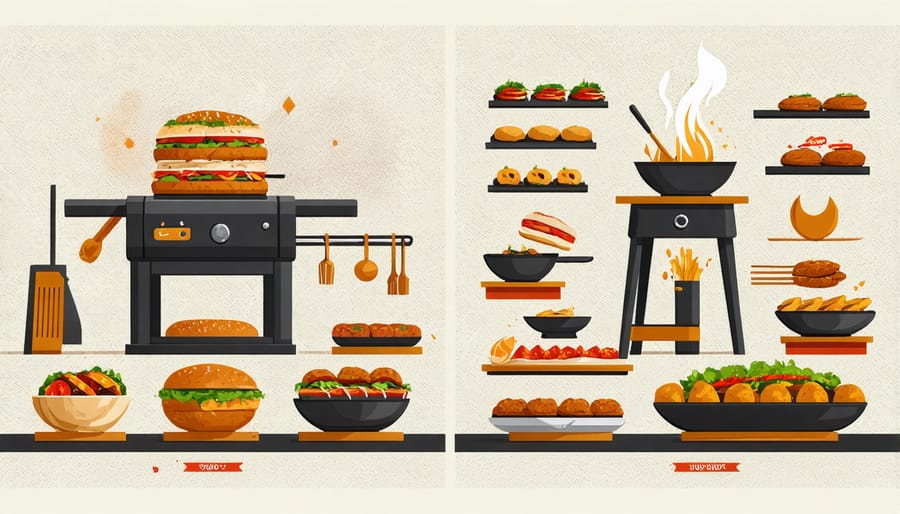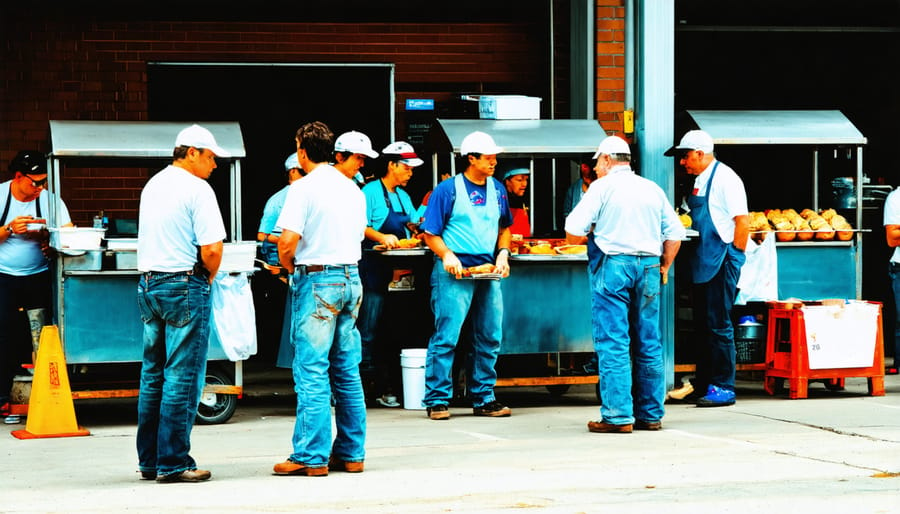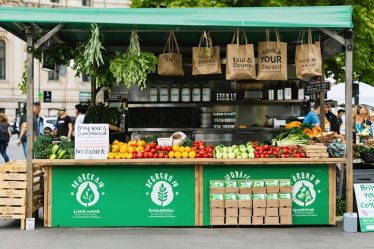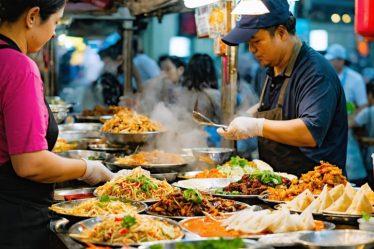
Venture down any historic street, and you’ll discover the living, breathing stories etched into every corner vendor’s recipe, every spice blend passed through generations, and every cooking technique that tells the tale of how food shaped history. From the aromatic street markets of ancient Rome to today’s vibrant food trucks, street food has always been more than just sustenance—it’s a delicious window into our collective past.
Picture the bustling markets of 18th-century London, where oyster sellers’ melodic calls echoed through cobblestone streets, or imagine the steam rising from pushcarts in 1900s New York, where immigrant families built new lives one hot dog at a time. These humble beginnings laid the foundation for the rich tapestry of flavors we enjoy today.
What makes street food truly remarkable isn’t just its accessibility or affordability—it’s how it captures the essence of human resilience and creativity. Every bite tells a story of cultural exchange, adaptation, and survival. Whether it’s Mexican tacos influenced by Lebanese immigrants or American hot dogs inspired by German wursts, these beloved street eats carry centuries of cultural cross-pollination in their recipes.
Today, as we grab a quick bite from our favorite food truck or street vendor, we’re not just satisfying our hunger—we’re participating in a tradition as old as civilization itself, keeping alive the flavors and techniques that our ancestors perfected through countless generations.
From Trade Routes to Food Carts: The Journey Through Time
Ancient Markets and Trading Posts
Picture bustling marketplaces filled with aromatic spices, colorful produce, and the excited chatter of traders from distant lands. These ancient markets weren’t just places to buy and sell goods – they were the original melting pots where culinary exchange between cultures flourished and shaped the street food we know today.
I’m always fascinated by how these trading posts served as the hearts of their communities. From the ancient Roman Forum to the busy ports of Southeast Asia, merchants would gather to trade not just ingredients, but also cooking techniques and recipes. Imagine the first time someone in medieval Europe tasted exotic spices from the Silk Road, or when Mediterranean olive oil made its way to Asian kitchens!
These markets created natural gathering spots where travelers could grab quick, affordable meals while conducting business. Clever food vendors set up stalls near popular trading routes, creating what we might consider the world’s first food courts. They knew exactly what their customers needed: convenient, filling meals that could be eaten on the go.
What’s particularly heartwarming is how these ancient market traditions continue today. When I visit modern farmers’ markets or food halls, I can’t help but feel connected to those early traders who gathered in similar spaces centuries ago, sharing stories and flavors that would eventually become beloved street food traditions around the world.

Immigration Waves and Food Evolution
Every wave of immigration has brought new flavors and cooking techniques to our streets, creating the vibrant food scene we know today. I remember my grandmother telling stories about how her neighborhood transformed with each new group of arrivals, each bringing their own cherished recipes and cooking traditions.
In the late 1800s, Italian immigrants introduced the beloved pizza slice and hot sausage sandwiches to bustling city streets. These humble beginnings transformed into the food cart culture we see today. The early 1900s saw an influx of Eastern European families, who brought their hearty pierogies and savory knishes to street corners, feeding hungry factory workers during the industrial boom.
Post-World War II, Greek and Middle Eastern immigrants added gyros and falafel to the mix, while the 1960s and 70s welcomed Vietnamese, Thai, and Korean influences. These newcomers introduced bánh mì sandwiches, pad thai, and bulgogi, adding exciting new dimensions to street food offerings.
The 1980s and 90s saw Latin American influences surge, with Mexican taco trucks and Salvadoran pupusa stands becoming neighborhood fixtures. Today’s food trucks and street vendors continue this beautiful tradition of cultural exchange, with fusion dishes that blend multiple immigrant influences into exciting new combinations.
What’s particularly wonderful is how these different waves of immigration didn’t just add new foods – they created entirely new traditions that now feel quintessentially American.
Cultural Crossroads in the Kitchen
Fusion Before It Was Trendy
Long before food fusion became a trendy restaurant concept, street food vendors were naturally blending culinary traditions out of necessity and innovation. These early fusion pioneers understood that cultural identity through food wasn’t about rigid boundaries, but rather about adaptation and creativity.
Take, for instance, the beloved Vietnamese bánh mì. This iconic sandwich combines French baguettes (introduced during colonial times) with traditional Vietnamese ingredients like pickled vegetables and cilantro. It’s a delicious reminder of how historical circumstances can create unexpected culinary masterpieces.
In Malaysia, the Nyonya cuisine emerged from Chinese immigrants adapting their cooking to local Malay ingredients and techniques. Street vendors were at the forefront of this fusion, creating dishes that today are considered traditional staples of Malaysian food culture.
Even the humble hot dog has a fusion story to tell. German immigrants brought their frankfurters to America, but it was street vendors who transformed them into the quintessential American street food by adding local touches like yellow mustard and sauerkraut.
The streets of Mexico City tell a similar tale, where Lebanese immigrants in the early 1900s adapted their shawarma-style cooking to local tastes, eventually giving birth to tacos al pastor. They swapped lamb for pork and added Mexican chilies and pineapple, creating something entirely new yet authentically Mexican.
These examples show us that fusion cuisine isn’t just a modern invention – it’s been happening naturally on street corners around the world for generations.

Preservation Techniques That Shaped Traditions
Have you ever wondered why so many beloved street foods seem to have such deep historical roots? The answer often lies in ancient preservation techniques that our ancestors developed out of necessity. Before the era of refrigeration, communities worldwide created ingenious methods to keep food fresh and edible for longer periods.
Salt-curing, smoking, and fermentation weren’t just preservation techniques – they became the foundation for many of the flavors we crave today. Take for instance the popular street food staples like smoked sausages in Germany or pickled vegetables in Korea. These weren’t originally created as delicacies, but rather as practical solutions for storing food through harsh winters or long journeys.
I remember my grandmother telling me how her mother would preserve vegetables in large ceramic crocks, using fermentation methods passed down through generations. Today, those same techniques give us the tangy kimchi served from food carts and the preserved lemons that add zest to Mediterranean street dishes.
Drying was another crucial preservation method that shaped street food culture. Sun-dried tomatoes, jerky, and dried fish became portable, long-lasting food options that eventually evolved into convenient street snacks. In many Asian countries, the tradition of drying noodles led to the development of quick-cooking varieties that are now essential to street food stalls.
These preservation methods didn’t just keep food edible – they created new flavors and textures that became deeply embedded in local culinary traditions. What started as survival techniques transformed into the distinctive tastes that make street food so irresistible today.
From Necessity to Cultural Icon
Working Class Heroes
When the Industrial Revolution transformed cities worldwide, street food emerged as a vital lifeline for the working class. Picture the bustling streets of 19th-century London, where laborers would grab a quick bite of hot, filling fare between long factory shifts. These humble street vendors became the unsung heroes of urban sustenance, providing affordable meals that kept the wheels of industry turning.
In many industrial hubs, women entrepreneurs known as “cook-shop ladies” would set up makeshift stands near factory gates, serving everything from meat pies to bowls of steaming soup. These early food vendors understood their customers’ needs perfectly – quick service, hearty portions, and prices that wouldn’t break a worker’s modest wages.
I’m reminded of my grandmother’s stories about her mother, who worked in Manchester’s textile mills. She’d tell me how street food vendors were more than just food suppliers – they were part of the community’s fabric, offering credit when times were tough and remembering each worker’s favorite dishes.
This tradition of accessible, filling street food continues today in industrial areas worldwide. From taco trucks serving construction sites in Los Angeles to Mumbai’s dabbawallas delivering home-cooked meals to office workers, street food vendors still play a crucial role in feeding our workforce, carrying forward a legacy that began with those first industrial revolution food stands.

Modern Revival and Recognition
Street food’s journey from humble beginnings to culinary stardom is nothing short of remarkable. Over the past decade, we’ve witnessed a fascinating transformation as these authentic dishes have captured the hearts (and taste buds) of food enthusiasts worldwide. Social media has played a huge role in this revival, with Instagram-worthy food trucks and market stalls becoming cultural landmarks in their own right.
What’s particularly exciting is how celebrity chefs and food documentaries have helped elevate street food from simple sustenance to celebrated cuisine. Shows like “Chef’s Table: Street Food” have introduced millions to the passionate vendors and their generational recipes, bringing well-deserved recognition to these culinary artisans.
Food festivals and markets have become weekend destinations, where traditional street food vendors share space with innovative food entrepreneurs. This beautiful blend of old and new has created vibrant community spaces where people connect over shared plates and stories.
The modern revival has also sparked important conversations about food heritage and preservation. Many young chefs are now returning to their roots, learning family recipes, and giving them contemporary twists while respecting their historical significance. This movement isn’t just about trendy food spots – it’s about preserving cultural identity and ensuring these time-honored traditions continue to thrive in our modern world.
Preserving Food Heritage Today
In recent years, there’s been a heartening surge in efforts aimed at preserving culinary traditions, particularly when it comes to street food heritage. I’ve witnessed firsthand how local communities are coming together to protect these precious recipes and techniques that have been passed down through generations.
Food festivals celebrating traditional street fare have become increasingly popular, not just as tourist attractions but as vital platforms for veteran vendors to share their knowledge with younger generations. In my neighborhood, for instance, we have an annual street food festival where elderly cooks mentor aspiring food entrepreneurs, ensuring their secret recipes and time-honored techniques don’t fade away.
Social media has unexpectedly become a powerful ally in this preservation effort. Food bloggers and cultural historians are documenting traditional preparation methods, creating digital archives that capture the stories behind beloved street dishes. These modern platforms are helping to bridge the gap between old-world wisdom and contemporary food culture.
Many cities are now implementing programs to protect their street food heritage. Singapore’s hawker culture, recently recognized by UNESCO, serves as an inspiring example of how traditional street food can be preserved while adapting to modern health and safety standards. Similar initiatives are sprouting up worldwide, with food vendors receiving support to maintain their authentic cooking methods while meeting contemporary requirements.
Community cooking classes focused on street food traditions have also gained popularity. These hands-on experiences allow food enthusiasts to learn directly from experienced vendors, ensuring that traditional techniques and flavors continue to thrive. It’s heartwarming to see grandmothers teaching their secret recipes to eager students, creating a living bridge between past and present.
The movement to preserve street food heritage isn’t just about maintaining recipes; it’s about protecting the cultural stories, community bonds, and social fabric that these beloved dishes represent.
As we reflect on the rich tapestry of street food heritage, it’s impossible not to feel a deep connection to the generations of vendors who came before us. Each sizzling wok and steaming cart tells a story of resilience, creativity, and cultural preservation that continues to enrich our lives today. I’m reminded of my grandmother’s stories about watching street vendors in her childhood, their techniques passed down through families like precious heirlooms.
Understanding these historic roots isn’t just about preserving recipes – it’s about maintaining the vibrant community spaces that street food creates. These culinary traditions have survived wars, migrations, and dramatic social changes, adapting while keeping their essential character intact. They represent both our past and our future, showing how food can bridge generations and cultures.
In our fast-paced modern world, street food traditions offer something invaluable: authentic connections to our shared human experience. Whether it’s a generations-old dumpling recipe or a century-old technique for grilling satay, these culinary practices deserve our attention and protection.
By supporting local street food vendors and sharing their stories, we become part of this living history. Each time we choose street food over fast food, we’re helping preserve these irreplaceable cultural treasures for future generations. Let’s celebrate and protect these delicious links to our past, ensuring they continue to flavor our cities and communities for years to come.



